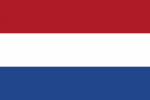
Netherlands Indies
Quick reference
General issues: Dutch colony 1864-1942, Dutch colony 1945-1948, Dutch colony renamed Indonesia 1948-1949
Country name on general issues: Ned Indie, Nederl Indie, Nederlandsch Indie
Special issues:
- Regional issues: Java 1908, Buiten Bezit 1908,
- Japanese occupation: Java 1943-1945, Sumatra, local issues 1942-1943, general issues 1943-1945, Naval Control Area, local issues 1942-1943, general issues 1943-1945
Related issues:
- Republic of Indonesia: Regional issues Java 1945-1949, Sumatra 1945-1949, general issues 1948-1949
Currency: 1 Gulden = 100 Cent 1864-1949
Population: 42 746 000 in 1900, 74 118 000 in 1949
Political history Netherlands Indies
Establishing Dutch rule
The Netherlands Indies[1]Also known as the Dutch East Indies or Netherlands East Indies, currently Indonesia is a Dutch colony located in southeastern Asia. The first Dutch settlements in the Netherlands Indies date from the 16th century. In the 17th and 18th century the Netherlands Indies is the domain of the Dutch East Indies Company, a chartered company focused on trade, but with certain administrative powers in the Netherlands Indies. In 1798, the administration of the Netherlands Indies is taken over by the Dutch government.
The British and the Dutch, in 1824, define their respective spheres of influence in southeastern Asia, the Malayan peninsula going to Great Britain and the Netherlands Indies to the Netherlands. At this occasion the British settlement of Bencoolen on Sumatra is exchanged for the Dutch settlement of Malacca on the Malayan peninsula.
Direct Dutch colonial administration, until the end of the 19th century, only exists in limited parts of the Netherlands Indies, mainly on Java and in the Moluccas. In the remainder of the Netherlands Indies the Dutch exert their power through the local rulers – a deliberate policy called ‘onthoudingspolitiek’. Towards the end of the 19th and in the early 20th the Dutch extend direct colonial rule to all of the Netherlands Indies – which sometimes requires armed force.
Japanese occupation
In WWII, the Netherlands Indies is occupied by Japan in 1942. The Japanese form three administrative areas in the Netherlands Indies: Java and Sumatra – initially part of the Malaya administrative area – are administered as army areas, the rest of the Netherlands Indies is grouped together to form the Naval Control Area, administered by the navy. The Riau Islands are, for the duration of the Japanese occupation, part of the Malaya administrative area. After the Japanese capitulation in 1945, the Netherlands Indies – parts of which are occupied by British and United States forces – is returned to the Dutch.
Towards independence
However, during WWII, with Japanese support, preparations for an independent Indonesia have been made. Directly following the Japanese capitulation the independent republic of Indonesia is proclaimed. A war of independence is fought from 1945 until 1949. Parts of Indonesia are, at different times, under the control of the newly founded republic and the colonial Dutch regime. The republic has its strongholds mainly on Java and Sumatra. The Dutch form an number of states in the parts of the country they control, aiming at a federal structure for the administration of the country. In 1948, they change the name of the country from Netherlands Indies to Indonesia. Gradually, international pressure through the United Nations is rising for the Netherlands to recognize an independent Indonesia. Finally, in 1949 the United States of Indonesia is founded, an independent federation formed officially in association with the Netherlands. After a year, the republic of Indonesia is proclaimed – a unitary state with a central government. The association with the Netherlands ends in 1956.
Netherlands New Guinea
Netherlands New Guinea remains in Dutch hands after 1949. Indonesia claims the sovereignty over the territory, and in 1962 the dispute escalates into an armed conflict. Again, under international pressure, the Dutch agree to place Netherlands New Guinea under the control of the United Nations Temporary Executive Authority in the same year. In 1963 control is transferred to Indonesia and in 1969 Indonesia formally annexes Irian Barat[2]West Irian as the territory is called by Indonesia.
Postal history Netherlands Indies
Stamps are issued for the Netherlands Indies from 1864. A special issue appears in 1908 when stamps are overprinted ‘Java’ for use on Java and Madura and ‘Buiten Bezit'[3]‘Buiten Bezit’ translates to ‘Outer Possessions’ for use in the rest of the Netherlands Indies. The reason for this issue is a postal census.
While occupied by Japan, on Java stamps of the Netherlands Indies continue to be used initially, albeit only those stamps that did not show the portrait of the queen of the Netherlands. On Sumatra and in the Naval Control Area, overprints on issues of the Netherlands Indies would be used. These overprints were applied locally and exist in many forms. On Sumatra, in 1942, the stamps of Malaya were also used when Sumatra was part of the Malaya administrative area. Finally, stamps of Japan are found to be used in the Netherlands Indies. As of 1943, definitives of Japanese design and inscribed in Japanese are issued for each of the administrative areas of Java, Sumatra and the Naval Control Area.
After the war, the stamps of the colonial administration are used until 1949 – even in parts of the country that, after 1945, were controlled by the republic of Indonesia. From 1948 – following the name change of the country – the stamps issued by the colonial administration are inscribed ‘Indonesia’ rather than ‘Netherlands Indies’. The republic of Indonesia issues stamps for use in the territories it controls from 1945. All these are superseded in 1949 by the first issue of the independent United States of Indonesia and subsequent issues of the republic of Indonesia as it is formed in 1950.
In Netherlands New Guinea stamps of the Dutch colonial administration will be used until 1962.
Album pages
← Previous page: NepalNext page: Netherlands New Guinea →

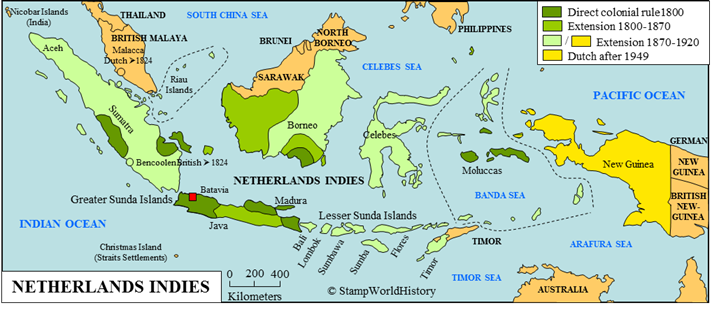
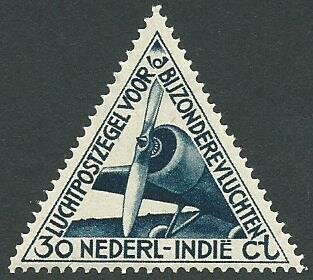
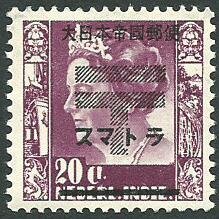
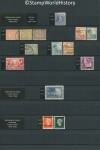

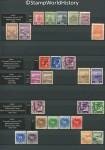
In Netherlands New Guinea section of Political history Netherlands Indies “Iran Barat” should be “Irian Barat”
William
Thanks again.